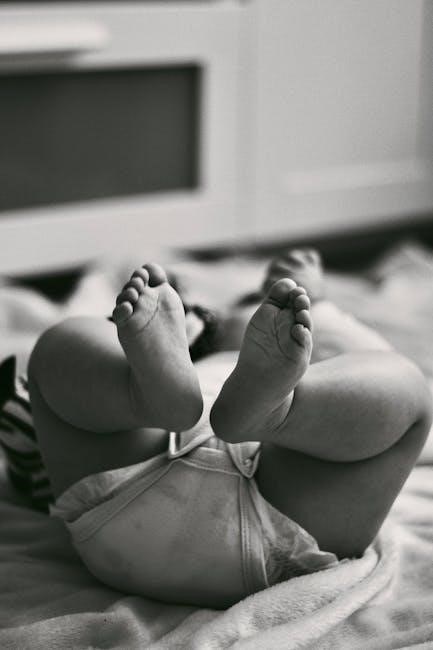Stockpiling diapers is a smart way to save money, time, and reduce stress for new parents. It ensures a steady supply, helping you stay prepared for your baby’s needs while avoiding last-minute purchases. This guide offers practical tips and strategies to build an efficient diaper stockpile, from estimating sizes to finding the best deals. Start your journey to a stress-free diaper supply today!
What is a Diaper Stockpile?
A diaper stockpile is a prepared supply of diapers stored in advance to ensure availability and convenience for your baby’s needs. It involves purchasing diapers in bulk or gradually accumulating them over time to avoid frequent purchases at higher prices. This strategy helps parents save money, reduce stress, and stay prepared for their baby’s growth. A well-planned stockpile considers factors like diaper sizes, baby’s growth rate, and storage space. It’s a practical approach to managing one of the most essential items for your little one, ensuring you’re never caught off guard.
Why Stockpile Diapers?
Stockpiling diapers offers numerous advantages for new parents. It saves money by allowing bulk purchases at discounted prices and avoids last-minute, costly buys. A stockpile ensures convenience, reducing the need for frequent trips to the store. It also provides peace of mind, knowing you’re prepared for your baby’s needs as they grow. Additionally, it helps avoid shortages and ensures you have a steady supply, especially during emergencies or sales shortages. Stockpiling diapers is a practical way to manage expenses and stay organized for your baby’s care.

Benefits of Building a Diaper Stockpile
Building a diaper stockpile offers significant financial and practical benefits. It allows you to save money by purchasing diapers in bulk at discounted prices, reducing long-term costs. A stockpile ensures you’re always prepared, eliminating last-minute trips to the store. It also provides peace of mind, knowing you have a steady supply as your baby grows. Additionally, stockpiling helps avoid shortages and allows you to take advantage of sales and coupons. This strategy is especially useful for families with limited storage space, as it encourages organized planning and reduces waste. A well-managed stockpile is a smart investment for your baby’s care.

Estimating Diaper Needs
Estimating diaper needs involves considering baby growth, size changes, and usage rates. Plan ahead to ensure a steady supply without overstocking. Sales and storage space matter too.
How Many Diapers Does a Baby Use in the First Year?
A baby typically uses 2,500 to 3,000 diapers in the first year, with newborns requiring 10-12 diapers daily. This number decreases as babies grow, with toddlers using about 5-6 diapers per day. Factors like size, growth rates, and potty training timelines influence overall usage. Knowing this estimate helps parents plan their stockpile effectively, ensuring they have enough diapers without overbuying. Stocking up on smaller sizes initially and transitioning to larger ones as needed is a practical approach to managing diaper supply efficiently.
Understanding Diaper Sizes and Growth Rates
Diaper sizes range from newborn to size 6 or pull-ups, accommodating a baby’s growth. Newborn sizes fit babies up to 8 pounds, while larger sizes cater to toddlers. Stockpiling sizes 1, 2, and 3 is recommended, as they are used the most. Start with a few newborn diapers, as babies outgrow them quickly. Consider your baby’s growth rate and brand-specific sizing variations. Purchasing larger sizes in smaller quantities initially allows flexibility. This approach ensures you have the right fit without wasting money on unused diapers, helping you manage your stockpile efficiently as your baby grows.
Creating a Diaper Stockpile Chart
A diaper stockpile chart helps you track and organize your diaper supply effectively. Start by estimating your baby’s needs based on size and growth rate. Allocate columns for diaper sizes (1-6) and rows for months. Fill in the number of diapers needed for each size and month. This visual tool ensures you don’t overstock or run out. Begin with smaller quantities for newborn sizes, as babies grow quickly. Adjust the chart as you monitor your baby’s growth and usage patterns. This organized approach helps you maintain a balanced stockpile and avoid wasted diapers. Use it to stay prepared and save money efficiently.

Choosing the Right Diapers
Selecting the right diapers involves considering absorbency, comfort, and your baby’s skin type. Disposable diapers offer convenience, while cloth diapers are eco-friendly and cost-effective. Test different brands to find the best fit for your baby, ensuring they prevent leaks and irritation. Always check for certifications like hypoallergenic or eco-friendly options to suit your preferences. The right choice enhances comfort and reduces the risk of skin issues, making it a crucial step in your diaper stockpiling journey.
Disposable vs. Cloth Diapers: Pros and Cons
Disposable diapers are convenient, absorbent, and hygienic, with features like wetness indicators. They are ideal for busy parents but can be costly long-term and contribute to landfill waste. Cloth diapers are eco-friendly, budget-friendly over time, and better for sensitive skin, though they require washing and maintenance. Consider your lifestyle, budget, and environmental preferences when choosing. Many parents opt for a mix, using disposables for convenience and cloth for sustainability. Both options have benefits, so weigh the pros and cons to decide what works best for your family and diaper stockpiling goals.
Diaper Brands: What to Look For
When selecting diaper brands, prioritize absorbency, comfort, and skin-friendly materials. Look for brands offering multiple sizes and features like wetness indicators. Consider your baby’s sensitivity and opt for hypoallergenic options if needed. Compare prices and value, as some premium brands may offer better durability. Eco-conscious parents might prefer sustainable or biodegradable options. Check reviews and recommendations from other parents to ensure reliability. Store return policies are also crucial in case a brand doesn’t work for your baby. Balancing quality, cost, and convenience will help you choose the best brand for your stockpile and your baby’s needs.
Considering Baby’s Skin: Allergies and Sensitivities
When stockpiling diapers, it’s crucial to consider your baby’s skin health. Many babies develop allergies or sensitivities to certain materials, dyes, or fragrances in diapers. Opt for hypoallergenic or fragrance-free options to minimize irritation. Look for brands that use natural, breathable materials and avoid harsh chemicals. If your baby has sensitive skin, consider eco-friendly or organic diapers. Always monitor for signs of irritation and adjust your stockpile accordingly. Testing different brands before stockpiling can help identify the best fit for your baby’s skin, ensuring comfort and preventing potential allergic reactions.

Where to Buy Diapers for Stockpiling
Online retailers like Amazon, Walmart, and Target often offer discounts and bulk deals. Store sales events and membership programs can also provide significant savings on diapers.
Best Online Retailers for Diaper Deals
Amazon, Walmart, and Target are top choices for diaper stockpiling, offering bulk discounts, free shipping, and subscription services. Amazon’s Subscribe & Save provides up to 20% off, while Walmart and Target often match prices and offer rollback deals. These retailers frequently feature coupon codes and sales events, making them ideal for building your stockpile efficiently. Additionally, online shopping saves time and effort, allowing you to compare prices and avoid in-store trips. Sign up for newsletters to stay updated on promotions and maximize your savings.
Using Coupons and Discounts Effectively
Maximizing savings with coupons and discounts is key to building your diaper stockpile. Look for manufacturer coupons on brand websites, apps like Ibotta or Fetch Rewards, or email newsletters. Combine these with store sales or cashback apps for even greater discounts. Many retailers accept multiple coupons per transaction, allowing you to stack savings. Additionally, sign up for rewards programs to earn points redeemable for future purchases. Always check expiration dates and plan your shopping trips during sales events to maximize your stockpile growth without overspending. This strategic approach ensures you save money while preparing for your baby’s needs.
Store Loyalty Programs and Sales Events
Joining store loyalty programs can significantly boost your diaper stockpile savings. Many retailers offer exclusive discounts, points, or rewards for frequent shoppers. Keep an eye on weekly ads and plan purchases during sales events, such as “Buy One, Get One Free” or percentage-off deals. Timing bulk buys during these periods maximizes savings. Additionally, some stores offer loyalty points redeemable for future purchases, helping you stock up even more efficiently. Always check for special promotions and align them with your diaper needs to build your stockpile without overspending.

Storing and Organizing Your Diaper Stockpile
Proper storage keeps your diaper stockpile fresh and accessible. Use airtight containers or shelves to organize sizes, ensuring easy access and maintaining quality over time.
Space-Saving Storage Solutions
Maximizing space is crucial for storing your diaper stockpile. Consider using stackable plastic bins, shelves, or under-bed storage containers to keep diapers organized and out of the way. Utilize vertical space with wall-mounted shelves or hooks for hanging diaper bags. Label each storage unit by diaper size to ensure easy access. For smaller areas, opt for collapsible bins or drawer organizers. These solutions help maintain a clutter-free environment while keeping your diaper supply within reach. A well-organized storage system ensures your stockpile remains practical and efficient, saving both space and time.
How to Keep Track of Your Diaper Supply
Tracking your diaper stockpile is essential to avoid overstocking or running out. Use a spreadsheet or a simple notebook to record purchases, sizes, and quantities. Label each storage bin with its contents and sizes for quick identification. Regularly count your supply and update your records. Consider using apps or digital tools designed for inventory management. This helps you stay organized and ensures you always know how many diapers you have on hand. Routine checks will also help you identify when it’s time to restock or adjust your purchasing habits based on your baby’s growth and needs.
When to Stop Buying: Avoiding Overstocking
Knowing when to stop buying diapers is crucial to avoid overstocking. A good rule of thumb is to stop when you have a 1-2 month supply based on your baby’s current size and growth rate. Overstocking can lead to wasted money if your baby outgrows a size or if diapers expire. Pay attention to storage space and ensure you’re not exceeding it. Track your supply regularly and adjust purchases accordingly. Stop buying once you’ve reached a comfortable stockpile level, balancing preparedness with practicality to avoid unnecessary waste and financial loss.

Managing Your Diaper Stockpile
Track your diaper supply, organize storage, and maintain a balanced stockpile to ensure efficiency and avoid waste. Regularly assess needs and adjust purchases accordingly.
Monitoring Expiration Dates and Diaper Quality
Regularly inspect your diaper stockpile for expiration dates and quality. Check for any signs of damage, discoloration, or packaging issues that may affect performance. While diapers don’t expire like food, their effectiveness can degrade over time. Store diapers in a cool, dry place to maintain quality. Avoid exposing them to extreme temperatures or moisture, as this can weaken adhesive tabs or cause the material to break down. Rotate your stock to ensure older diapers are used before they lose integrity. This practice helps prevent waste and ensures your baby always has reliable protection.
Rotating Your Stock: First-In, First-Out
Adopt the “first-in, first-out” (FIFO) method to manage your diaper stockpile effectively. This ensures older diapers are used before newer ones, preventing expiration or degradation. Organize diapers by purchase date or size, making it easy to grab the oldest ones first. Labeling batches or using storage bins with clear visibility can help maintain order. Regularly check for signs of wear or damage, as outdated diapers may lose absorbency or adhesive strength. By rotating your stock, you avoid waste and ensure your baby always has fresh, high-quality diapers available.
Returning or Exchanging Unused Diapers
Returning or exchanging unused diapers can help maximize your stockpile’s efficiency. Many retailers offer flexible return policies, allowing you to exchange unused diapers for different sizes or brands. Keep receipts and packaging to ensure smooth returns. Be mindful of expiration dates, as some stores may not accept returns after a certain period. Additionally, check for store credit options if direct exchanges aren’t possible. This approach helps avoid waste and ensures your baby always has the right fit and quality diapers available.

Additional Tips and Tricks
Discover practical advice to enhance your diaper stockpiling experience. Learn how to maintain your supply efficiently and adapt to your baby’s changing needs seamlessly. Start here!
Starting Small: A Beginner’s Approach
Beginners can start by stockpiling smaller quantities to avoid overwhelming themselves. Focus on buying sizes 1 and 2, as these are most commonly used. Set a budget and gradually add to your stockpile. Use coupons, shop during sales, and consider smaller packages to test brands. Store diapers in a dry, cool place to maintain quality. This approach helps you learn your baby’s needs without overspending. Starting small ensures flexibility and reduces stress, making it easier to adjust as your baby grows. It’s a practical way to build confidence in your stockpiling journey.
Involving Family and Friends in Your Stockpile
Involving loved ones can make stockpiling easier and more enjoyable. Share your stockpile goals with family and friends, and ask for their support. They can contribute by purchasing diapers or helping you shop for deals. Consider creating a shared list or chart to track progress together. This not only lightens the workload but also spreads the cost. You can also organize a group effort to compare prices or split bulk purchases. Encourage others to buy diapers as gifts for showers or celebrations. This collective approach fosters teamwork and ensures your stockpile grows steadily without overwhelming you financially or logistically.
Common Mistakes to Avoid When Stockpiling
Overbuying a single size is a common mistake, as babies grow quickly. Avoid purchasing too many of one size, as this can lead to waste. Ignoring expiration dates on diapers is another error, as some may degrade in quality over time. Failing to organize your stockpile can result in expired or unused diapers. Additionally, buying too many different brands without testing them on your baby can lead to dissatisfaction. Lastly, not using a stockpile chart can cause overstocking or understocking. Be mindful of these pitfalls to ensure your stockpile remains practical and effective.
Building a diaper stockpile is a practical way to prepare for your baby’s needs, saving time, money, and stress. Start small, stay organized, and enjoy the benefits of being ready for whatever comes next!
Final Thoughts on Diaper Stockpiling
Diaper stockpiling is a wise investment for new parents, offering financial savings and peace of mind. By planning ahead and purchasing diapers in bulk, families can avoid the hassle of frequent trips to the store and reduce expenses. It’s essential to balance stockpiling with practicality, ensuring you don’t overbuy sizes your baby may outgrow quickly. With careful planning and smart shopping, a well-organized diaper stockpile can provide comfort and convenience during the early years of parenthood. Start small, stay organized, and enjoy the benefits of being prepared for your baby’s needs.
Encouragement to Start Your Diaper Stockpile
Starting a diaper stockpile is a proactive step toward saving money and reducing stress as a new parent. It’s a simple yet effective way to prepare for your baby’s needs. Even if you begin with a small stash, every diaper saved is one less trip to the store. Remember, the goal is to be prepared, not overwhelmed. With a well-planned stockpile, you’ll enjoy the peace of mind that comes with knowing you’re ready for whatever comes next. Take the first step today and begin building a diaper stockpile that will serve you and your baby well!
